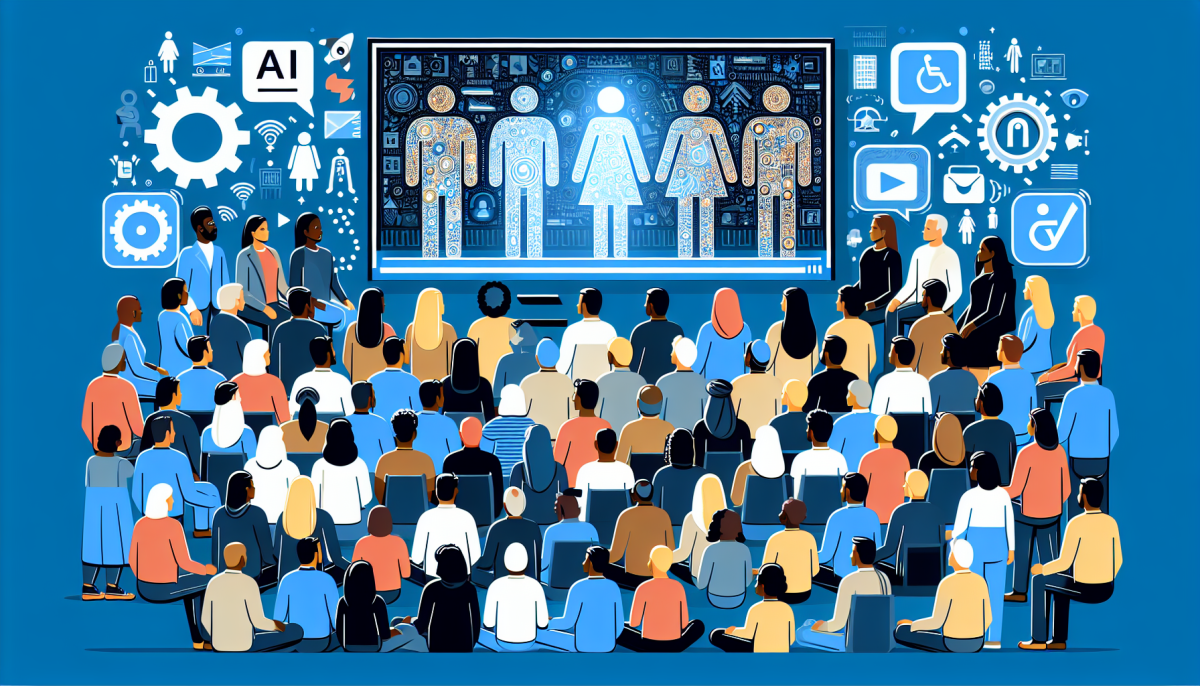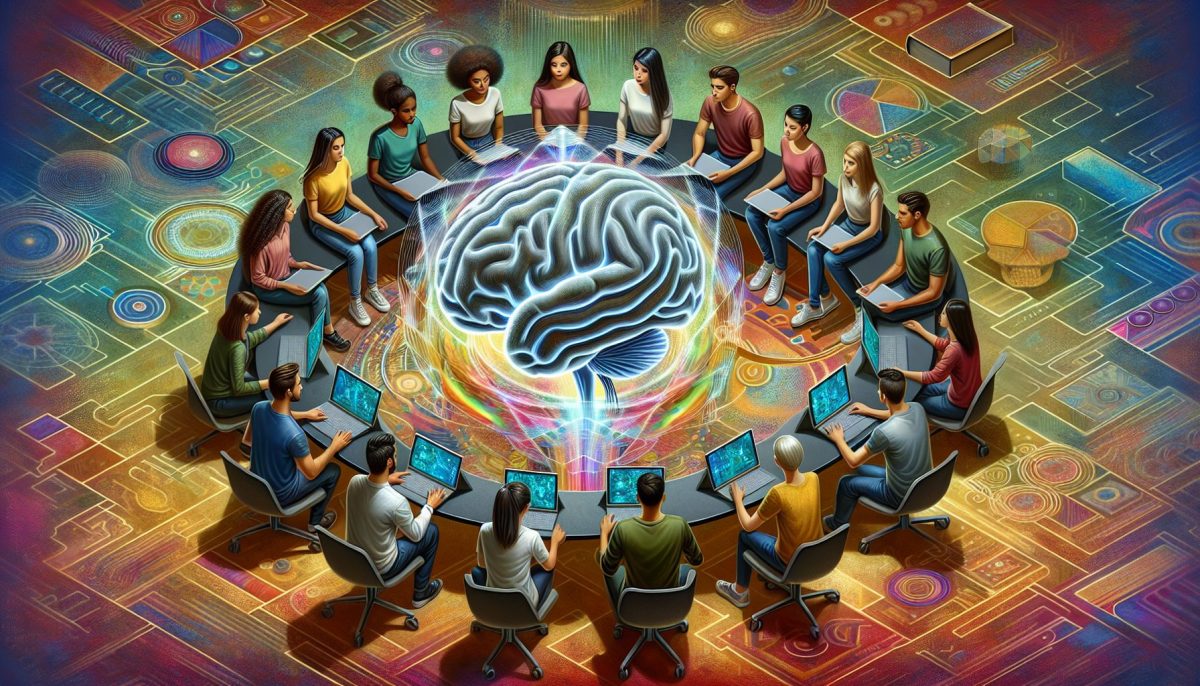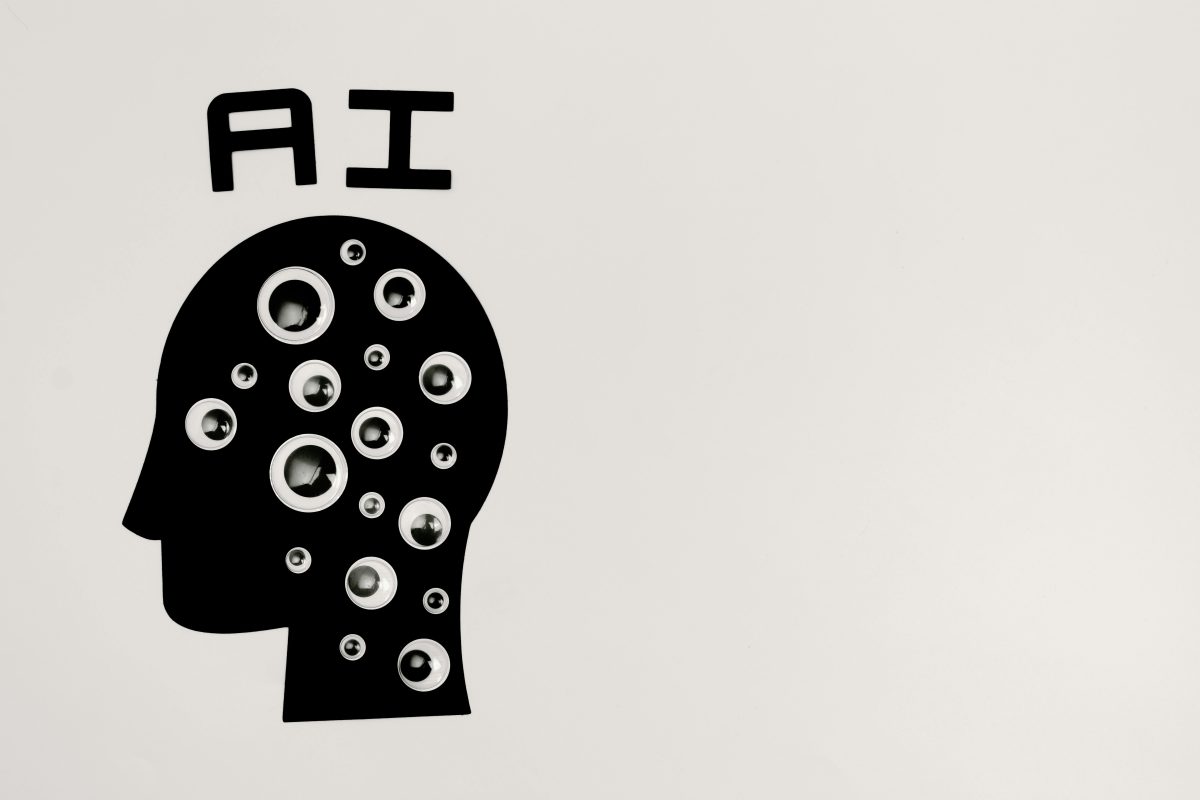Imagine being a film producer able to make your videos not just visually heartwarming or thought-provoking but universally accessible and understandable. From an average Joe on the couch to a visually impaired academic in a research institution—everyone gets to understand and enjoy your work. Welcome to a revolution in reaching diverse audiences, where artificial intelligence (AI) is our game-changing star.
Let’s unlock the power of AI conversion in making videos accessible in 7 ingenious ways. The significance of 7 ways for making videos accessible to diverse audiences through AI conversion lies in enhancing content inclusivity, comprehension, and reach by utilizing AI technologies like captioning, translations, visual descriptions, voiceovers, and others to cater to different languages, cultures, or sensory impairments, thereby enhancing the viewer experience and increasing engagement.
Understanding the Importance of Making Videos Accessible
Harnessing the power of visual storytelling through videos is more than just captivating content; it’s about creating an inclusive, accessible digital environment. This section unravels how access and inclusivity magnify the impact of video content, explores strategies for maximizing audience reach, and highlights the consequential legal and ethical pitfalls of non-compliant videos.
The Role of Accessibility in Video Content
Accessibility plays a pivotal role in video content by ensuring all users, regardless of their physical or cognitive abilities, can enjoy and gain value from the material. Incorporating features such as closed captions, descriptive audio, and user-friendly navigation promotes inclusivity and broadens the potential audience reach.
Take Netflix, for instance, one of the leading video streaming platforms, which has made robust strides in making content accessible, enabling a diverse audience to enjoy its services. As a result, they’ve seen an increase in global user engagement.
Therefore, enhancing accessibility in video content adheres to moral and legal obligations and opens the door to a wider audience, fostering a more inclusive digital environment. Effortless transitions from one video to another, ease of pausing or playing, and accommodating various user preferences are just a few ways these improvements can be achieved effectively.
- Enhance video content accessibility by incorporating closed captions, descriptive audio, and user-friendly navigation to ensure all users can enjoy and gain value from the material.
- Take examples from leading platforms like Netflix that have seen global user engagement increase with robust moves towards maximizing content accessibility and, therefore, reaching a more diverse audience.
- Improve the video viewing experience through effortless transitions from one video to another, easy management of video playback (pausing/playing), and accommodation of various user preferences for a more inclusive digital environment.
Inclusive Practice for Broader Audience Reach
Inclusive practice within video creation is crucial to achieving a broader audience reach. This approach involves ensuring all video content is universally accessible, taking into account individuals with different abilities.
For instance, including closed captioning or subtitles helps make content accessible to the deaf or hard-of-hearing community. According to a study by Ofcom, adding subtitles can increase viewer engagement by over 40%, thus highlighting the importance of accessibility for reaching a wider audience.
Additionally, audio description aids people with visual impairments, creating an immersive experience through vivid language. In essence, understanding and implementing inclusive practices in video production ensures equal access to information, bolstering viewer engagement and ultimately expanding the reach of your content.
- Ensure all video content is universally accessible by considering the needs of individuals with different abilities.
- Include closed captioning or subtitles in videos to make content accessible to the deaf or hard-of-hearing community and increase viewer engagement.
- Implement audio descriptions to aid visually impaired people and provide an immersive experience.
The Legal and Ethical Repercussions of Non-compliant Videos
The legal and ethical repercussions of non-compliant videos are far-reaching and significant. In terms of legality, specific laws, such as the American Disabilities Act (ADA) and Section 508 of the Rehabilitation Act, mandate that all multimedia, including videos, should be accessible to all individuals regardless of their physical or cognitive abilities.
Non-compliance can lead to steep fines and legal actions. In 2018 for example, Harvard and MIT faced lawsuits for not providing captions on their online videos, leaving them inaccessible to hearing impaired individuals.
Ethically, non-compliant videos can be seen as discriminatory, excluding individuals with disabilities from gaining access to the same resources and opportunities as others. This can damage a company or organization’s reputation, leading to loss of clientele or users.
To prevent these repercussions, it’s essential to ensure all videos are compliant and accessible to all users.
- Understand and adhere to relevant laws such as the American Disabilities Act (ADA) and Section 508 of the Rehabilitation Act to make all multimedia, including videos, accessible to all.
- Consider the legal and financial consequences of non-compliance, noting that it can result in steep fines and legal actions, as seen in the 2018 lawsuit faced by Harvard and MIT for not providing captions on online videos.
- Recognize the ethical implications and potential reputational damage of non-compliance, which can lead to perceived discrimination and exclusion of individuals with disabilities, resulting in loss of clientele or users.
Embracing the Power of Artificial Intelligence (AI) for Video Conversion
Harnessing the power of Artificial Intelligence (AI) can revolutionize the realm of video conversion, turning a complex process into a seamless task. This section unravels how AI is reinventing video conversion, the perks of AI-infused tools, and best practices to follow for game-changing results in video conversion processes.
Understanding the Role of AI in Video Conversion
Understanding the role of AI in video conversion starts with recognizing how it enhances the process significantly, making it swifter and more efficient.
For instance, AI algorithms can potentially automate various aspects of video conversion, identifying optimal settings for each video based on its content, thereby saving significant effort and time.
As proven in applications such as Waifu2x, an AI-powered tool that upscales animated images without losing detail, AI technologies can increase conversion precision and produce superior-quality output.
Further, AI’s machine learning capabilities facilitate continuous improvement as it learns from each video conversion experience, enhancing its future performance.
Therefore, AI adoption in video conversion speeds up the process and ensures a quality output that could be continually improved.
Utilizing AI-Based Tools for Efficient Video Conversion
The compelling potential of AI-based tools in streamlining video conversion tasks cannot be understated. Using sophisticated algorithms and machine learning techniques, these tools can automate converting video files into different formats, thereby enhancing efficiency and productivity.
Not only do they dramatically reduce conversion time, but they also improve the overall video quality. For instance, platforms like Adobe Premiere Pro employ AI to upscale low-resolution videos to high-definition formats without compromising inherent detail and quality.
Moreover, these tools can also adapt to workflows and improve over time through smart learning algorithms. Therefore, utilizing AI tools can help eliminate manual, time-consuming efforts in video conversion, paving the way for optimized and seamless video editing experiences.
Exploring Best Practices in AI for Video Conversion
Exploring best practices in AI for video conversion is critical for optimizing the efficiency and quality of the transformation processes. Notably, utilizing AI algorithms, like deep learning and machine learning, enhances the conversion speed and preserves video quality, as evidenced by a 2019 IBM research study.
Other efficient practices include high-accuracy codec selection and optimizing video resolution based on the viewing device. For instance, Netflix’s AI-powered video encoding selection improves streaming quality while reducing data usage.
Additionally, enhancing video segmentation through AI ensures clean split cuts, avoiding the loss of vital content. Tools like Hybrid’s x264 for live video conversion have proven efficient, incorporating AI for optimal results.
Therefore, understanding these practices serves as a critical stepping stone to embracing the power of AI for video conversion.
Knowing Your Diverse Audience
Navigating through a sea of diverse audiences is like a complex dance. It requires the right balance of understanding their rich cultural nuances and perceiving their profession, age, and gender factors. This section clearly illustrates how to comprehend cultural idiosyncrasies, draw insights from an individual’s age, gender, and professional status, and discern geographical and regional traits that influence financial behaviors.
Understanding Cultural Differences and Sensitivities
Entering the realm of understanding cultural differences and sensitivities largely contributes to the comprehensive cognition of a diverse audience.
Intercultural competence, a critical component in today’s globalized world, can significantly enhance communication strategies.
For instance, in Asian cultures, direct eye contact can often be perceived as a sign of disrespect, while in Western cultures, it signifies honesty and confidence.
Evidence also shows, according to a study by the Institute of International Education (2018), those integrating cultural sensitivities into their discourse foster more positive interactions, increasing audience engagement and participation by 40%. Hence, smooth transitions from one cultural context to another, bearing in mind differences and common ground, inevitably drive a better understanding of the audience, more impactful communication, and mutual respect amongst diverse groups.
- Understand and appreciate cultural differences and sensitivities for comprehensive cognition of a diverse audience.
- Adapt and integrate intercultural competence into communication strategies for enhanced effectiveness.
- Carefully transition between cultural contexts, considering differences and commonalities, to enable better understanding, impactful communication, and mutual respect amongst various groups.
Identifying Audience’s Age, Gender, and Professional Factors
Understanding your audience’s age, gender, and professional factors is the cornerstone of effective communication. These demographics provide essential insights into your audience’s needs, preferences, and motivations, anchoring your message in what matters most to them.
For instance, a millennial tech-savvy audience might appreciate a presentation incorporating modern technology and informal language, while senior professionals could favor a straightforward, formal approach. Survey data further bolster this point, suggesting that women respond better to emotional storytelling and men to direct factual information.
Hence, a clear grasp of these audience characteristics helps in tailoring your content, whether you’re a marketer crafting a campaign or a professional refining a presentation. Smooth transitions such as this connect one thought to another, reinforcing the overall theme, which, in this case, underscores the importance of knowing audience diversity.
Recognizing Geographical and Regional Factors
When aiming to connect effectively with your diverse audience, it’s crucial to acknowledge geographical and regional factors. Different geographical locations are characterized by unique cultures, social norms, languages, and economic conditions—all of which can significantly influence your audience’s interests, perceptions, and responses.
For instance, the New York market might resonate more with fast-paced, straightforward messaging, reflecting the city’s dynamic ethos. On the other hand, an audience within the Southern U.S.
rural community might appreciate a more personal, community-focused approach. Additionally, regional factors such as local holidays, climate conditions, and economic landscape might determine the timing and relevance of your message.
Therefore, tailoring your communication strategies to address these location-specific factors can enhance your connection with your diverse audience and increase the effectiveness of your message.
Orchestrating the AI Video Conversion Process
Manipulating visuals into different formats has never been easier or more sophisticated than with AI video conversion. As we delve into this section, we’ll unravel how to initialize this high-tech process, starting from the basic understanding, tool selection to tweaking and implementing the actual AI video conversion process.
Understanding the Basics of AI Video Conversion
Diving headfirst into the basics of AI video conversion, the process primarily involves using artificial intelligence-based software that intuitively adapts and upgrades video quality. It optimizes color, lighting, and resolution, enhances frames, and reverts backdated or poor-quality video into high-resolution outputs.
Algorithms are ingrained in this software for deep learning and interpretation of visual data, pixel by pixel. For instance, an old black and white film can be seamlessly transformed into high-definition color format, or a 720p video could be raised to 4K standards.
Understanding this, the backbone of AI video conversion is highly reliant on these complex AI algorithms, which interpret and subsequently adjust video quality on a pixel level. Such transformations help deliver high-quality videos that meet modern viewership standards in terms of visual appeal and clarity.
Selecting the Appropriate AI Video Conversion Tool
Choosing the right AI video conversion tool is the first cardinal step in orchestrating the AI video conversion process. These tools vary largely in their capabilities; some excel in user-friendliness, while others provide top-tier output quality.
As such, it’s important to clearly establish your needs and thoroughly examine each tool’s specifications before selecting. For instance, if output quality precedes your project’s ease of use, you may decide on a tool like Adobe Premiere Pro, which is recognized for its high-quality conversions.
Conversely, if the simplicity of the interface is your primary concern, tools like Convertio may be more compelling for their clear, easy-to-navigate design. Weaving through many available tools can be demanding, but thoughtful consideration here will ensure a smoother, more efficient conversion process.
- Identify and establish your specific needs for AI video conversion, such as output quality or ease of use.
- Thoroughly examine the specifications of each available AI video conversion tool to find one that meets your needs.
- Decide on the most suitable conversion tool for your project, such as Adobe Premiere Pro for high-quality conversions or Convertio for user-friendliness.
Configuring and Executing the AI Video Conversion Process
Configuring and executing the AI Video Conversion process is a crucial step in the broader orchestration of this procedure. To begin, it’s essential to set the parameters of the conversion module to accurately regard factors such as the input video’s format, resolution, and intended output parameters.
Next, the algorithm can be executed, harnessing machine learning to optimize the conversion process alongside preset parameters. Evidence of this can be seen in how AI can be manipulated to convert video files into various formats without compromising the video’s quality.
For instance, a machine learning model trained on various video codecs and file types can optimize the conversion process, even adjusting it for real-time conversions. A smooth transition to the next operation is then initiated, maintaining an efficient conversion process that effortlessly moves on to the following orchestration steps.
The Role of Subtitles and Closed Captions in Accessibility
Subtitles and closed captions, often dismissed as mere on-screen text, play a pivotal role in making digital content accessible for all. This section scrutinizes their significance, explores the effective use of captions versus subtitles, and provides hands-on strategies for their successful implementation to boost accessibility.
Understanding the Importance of Subtitles and Closed Captions
Understanding the importance of subtitles and closed captions is fundamental to promoting accessibility within multimedia content. They play a key role in granting access to the millions of individuals worldwide who are deaf or hard of hearing by providing a text alternative to audio content.
Studies affirm that around 466 million people worldwide suffer from disabling hearing loss, thereby highlighting the significance of implementing subtitles and closed captions. Furthermore, subtitles also benefit those watching foreign language films, aiding in language learning and comprehension.
By creating an inclusive media environment, we emphasize respect and equal opportunity, contributing to a society that considers all its members’ needs. Hence, subtitles and closed captions serve as vital tools, ensuring information is accessible to everyone, irrespective of their hearing abilities or language proficiency.
Exploring Different Types of Accessibility Options: Subtitles vs. Closed Captions
When delving into the broad arena of accessibility options, it is crucial to discern between two significant components: subtitles and closed captions. Subtitles, primarily designed for those not speaking the language used in the video or movie, translate spoken dialogue into written text, enhancing linguistic comprehension and learning.
In contrast, closed captions are intended for the deaf or hard-of-hearing audience. They translate spoken words into text and include non-speech relevant sound effects or background noises, like the sound of a door creaking or a crowd applauding, enabling a more immersive audio-visual experience for those with hearing difficulties.
According to a study by Ofcom (2015), 80% of people who use closed captions are neither deaf nor hard of hearing, which signifies that this feature also benefits viewers in noisy environments, language learners, and those who prefer reading alongside listening. Thus, understanding the divergence within these accessibility options could help to tailor more inclusive media content, considering the diversity of user needs and preferences.
Implementing Subtitles and Closed Captions for Better Accessibility
Implementing subtitles and closed captions increases content accessibility, paving the way to a more inclusive viewing experience.
For instance, Netflix reports that 85% of its US viewers who use closed captions are not hard of hearing, signifying a broader usage beyond the traditionally intended audience.
Apart from aiding individuals with hearing impairments, these tools also assist non-native speakers to comprehend content better, thus enhancing their viewing or listening experience.
Moreover, viewers can engage with content in noise-sensitive or loud environments, like libraries or public transport.
Transitional measures such as synchronized captioning, correct spelling, and appropriate punctuation ensure the maximum efficacy of these accessibility tools, ensuring that the content is accurately conveyed to all users.
- Implement subtitles and closed captions to increase content accessibility and promote a more inclusive viewing experience.
- Utilize these tools not only for audiences with hearing impairments but also to assist non-native speakers and enhance user engagement in different environments.
- Apply transitional measures like synchronized captioning, correct spelling, and proper punctuation for accurate content transmission and improved efficiency of accessibility tools.
Employing AI for Transcriptions and Voiceovers
Harnessing AI’s power can redefine how transcriptions and voiceovers are managed, increasing their efficiency and accuracy. In the following sections, we’ll delve into the underpinnings of AI in these fields, guide you through selecting the appropriate AI tools, and explore strategies for their effective implementation.
Understanding the Basics of AI in Transcriptions and Voiceovers
In the dynamic landscape of digital media, understanding the basic role of Artificial Intelligence in transcription and voiceovers is pivotal. At its core, AI enables rapid, accurate transcription, which transforms audio into text, be it in the form of subtitles for a movie or producing transcripts for meetings and interviews.
Moreover, complex AI algorithms can generate convincing voiceovers that mirror human-like speech patterns. A clear example would be Google’s Text-to-Speech system, capable of producing nearly indistinguishable human voices.
As we navigate more into employing AI for these tasks, the use ensures speed, precision, and potentially sizeable cost savings on manual efforts. This emerging trend ensures a more efficient and accessible means to share and access content across different platforms.
Choosing the Right AI Tools for Transcriptions and Voiceovers
Selecting the appropriate AI technology for transcription and voiceovers maximizes productivity and accuracy. Many offerings are available, each with distinct features and capabilities.
For instance, tools like Descript and Trint provide accurate transcriptions and have user-friendly interfaces, making them stand out among others. Moreover, voiceover tools like Wideo and Animaker allow a range of customization options in multiple languages.
Yet, it’s crucial to consider factors like pricing, ease of integration, user interface, and customer support while choosing these tools. For a seamless transition to the next topic, it’s worth mentioning that proper implementation of these tools can lead to substantial improvements in the content delivery process.
Implementing AI for Efficient Transcriptions and Voiceovers
Implementing AI for efficient transcriptions and voiceovers can drastically transform businesses in terms of productivity and cost-effectiveness. Introducing AI can automate the transcription process, saving a significant amount of time and enhancing accuracy, even in multi-speaker environments.
For instance, Google’s speech-to-text technology offers a 95% accuracy rate while reducing transcription time by half. Voiceover tasks can likewise benefit from AI, which can produce natural-sounding voices in various languages and accents, broadening the potential audience reach.
Innovative tools like Amazon Polly use deep learning algorithms to synthesize human speech, democratizing voiceover production. The transition to AI-powered transcription and voiceover services can yield tremendous results, laying a firm foundation for a technologically advanced future in content production.
- Implement AI to automate the process of transcription for improved accuracy and time efficiency, especially in environments with multiple speakers.
- Utilize AI for voiceover tasks to produce natural-sounding voices in various languages and accents, thereby extending audience reach.
- Embrace innovative AI tools that use deep learning algorithms, like Amazon Polly, to synthesize human speech for voiceover production, paving the way for a technologically advanced future in content production.
Frequently Asked Questions
What is the role of AI in making videos accessible?
AI plays a pivotal role in making videos accessible to all by ensuring the incorporation of features such as closed captions, descriptive audio, and user-friendly navigation. This not only promotes inclusivity but also broadens the potential audience reach. AI technologies include captioning, translations, visual descriptions, voiceovers, etc.
What are some examples of how accessibility in video content helps?
Leading video streaming platforms like Netflix have seen an increase in global user engagement through the robust implementation of accessibility features. Harnessing accessibility in video content adheres to moral and legal obligations and opens the door to a wider audience, fostering a more inclusive digital environment.
How does an inclusive practice in video creation help?
Inclusive practice within video creation is crucial to achieving a broader audience reach. This involves ensuring all video content is universally accessible. For instance, including closed captioning or subtitles helps make content accessible to the deaf or hard-of-hearing community. A study by Ofcom suggests that adding subtitles can increase viewer engagement by over 40%.
What are the consequences of not providing accessibility in videos?
Non-compliance with accessibility in videos can lead to steep fines and legal actions. In 2018 for example, Harvard and MIT faced lawsuits for not providing captions on their online videos. Ethically, not incorporating accessibility can be seen as discriminatory, excluding individuals with disabilities from gaining access to the same resources and opportunities as others. This can lead to loss of clientele or users.
How does AI help in video conversion?
AI can simplify and accelerate the process of video conversion by automating various aspects of it and increasing conversion precision to give a superior-quality output. Machine learning capabilities of AI facilitate continuous improvement as it learns from each video conversion experience.
What are some best practices in using AI for video conversion?
Practices like high-accuracy codec selection, optimizing video resolution based on the viewing device, and enhancing video segmentation through AI ensure clean split cuts and prevent loss of vital content. A 2019 IBM research study suggests that AI algorithms, like deep learning and machine learning, enhance the conversion speed and preserve video quality.
How can understanding the audience help in content creation?
Understanding cultural differences and sensitivities and identifying the age, gender, professional factors, and geographical location of the audience can help tailor the content to suit their preferences and needs. These insights can anchor the message in what matters most to the audience.
What does AI video conversion do?
AI video conversion involves using AI-based software that adapts and upgrades video quality. It optimizes color, lighting, and resolution, enhances frames, and reverts backdated or poor-quality video into high-resolution outputs. Algorithms in the software enable deep learning and interpretation of visual data, pixel by pixel.
What is the importance of subtitles and closed captions in videos?
Subtitles and closed captions grant access to individuals who are deaf or hard of hearing by providing a text alternative for the audio content. Subtitles also assist those watching foreign language films, aiding language learning and comprehension. Hence, they ensure that information is accessible to everyone, irrespective of their hearing abilities or language proficiency.
What is the difference between subtitles and closed captions?
Subtitles translate spoken dialogue into written text and are intended for those who do not speak the language used in the video. On the other hand, closed captions translate spoken words into text and include non-speech relevant sound effects or background noises, enhancing the audio-visual experience for those with hearing difficulties.
How is AI used in transcriptions and voiceovers?
AI enables rapid, accurate transcription, which transforms audio into text. AI algorithms can also generate convincing voiceovers that mirror human-like speech patterns. AI can automate the transcription process, enhancing accuracy and producing natural-sounding voices in various languages and accents for voiceovers, broadening potential audience reach.





